 Est. 2008; bringing nature, & gardeners together July 12, 2024
|
|
Three Vines to Plant; Two to Shoot Out of a Cannon into the Sun
By Lori Daul
The Best of Vines
MY HANDS-DOWN FAVORITE vine for Central Texas is our native crossvine (Bignonia capreolata), particularly the 'Tangerine Beauty' cultivar.
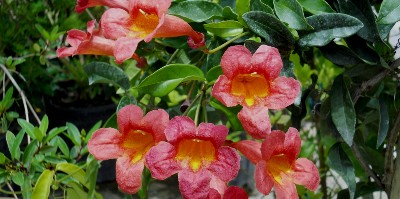 Crossvine does it all. It is extremely drought tolerant once established, it is evergreen, it is cold hardy to zone 6, and it can deal with full blazing hot sun to dappled shade.
When it is in full bloom in spring, it can literally stop traffic. Hummingbirds and other pollinators love it. I also appreciate the smaller flushes of flowers that appear after big rains in the summer and fall.
While it does great on a trellis, crossvine can also be trained directly up a wood fence or stone wall as it can attach itself with tendrils.
After a few years, the base of the vine can get woody. If that bothers you, chop it to the ground in the spring and then it'll bounce right back, full & hearty.
This vine is my go-to for providing privacy in a narrow space, now that clumping bamboos don't do well here — a free-standing 8' trellis just in front of the standard 6' fence with crossvine on it will do the job nicely and look good all year.
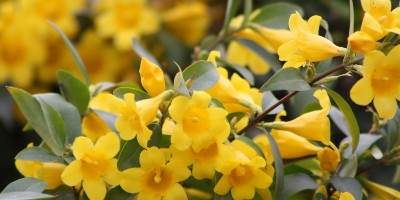
My runner up evergreen vine is Carolina jessamine (Gelsemium sempervirens).
Native to the southeastern US west to east Texas, it is extremely well adapted to central Texas's flood/drought/ heat/cold cycle. It has the stature to cover large trellises and arbors.
Unlike crossvine, it climbs by twining instead of tendrils, so it will not attach itself directly to structures. Carolina jessamine is the first vine to start blooming in early spring with bright yellow flowers while most plants are still dormant, adding a welcome pop of color while the days are still short. The flowers are also fragrant. Unlike crossvine, it doesn't reliably re-bloom throughout the season.
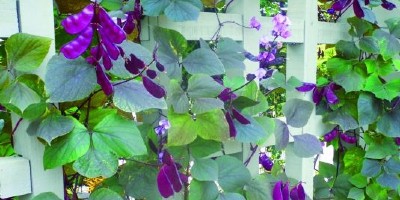
My third favorite vine is an annual vine — Hyacinth Bean Vine (Dolichos lablab). Sometimes you just want instant gratification, and Hyacinth Bean Vine is the answer.
It's easily available from seed, laughs at the heat, and is a great option to plant on a trellis when you're waiting for a perennial vine to fill in, or in the summer vegetable garden while you're taking a break from vegetables during the baking heat of June and July.
This fast-growing annual vine is closely related to pole beans, but with a much more flamboyant bent — the purple stems twine up supports and then explode into spears of magenta pink clusters of flowers that look almost like miniature sweet peas.
The flowers then mature into bright purple seed pods that are just as attractive as the flowers. The flowers and seed pods look good in floral arrangements.
While not sold as an edible, the flowers and seed pods of hyacinth bean vine are in fact edible — and taste like raw green beans! You can even freeze the flowers into ice cubes to make your drinks look fancy. ______________________________________________
The Worst of Vines
AND SWERVING FROM THE SUBJECT of favorites, there is a special place in Hell for people who plant the following vines in the ground:

Trumpet Vine (Campsis radicans) is often confused with crossvine. The only similarity is in the shape of the flowers. In every other respect, they differ. Trumpet Vine is a rampantly invasive deciduous vine that will travel underground (even under concrete!) and come up everywhere.
It chuckles indulgently at the presumption of "weed barrier." It loves to infiltrate cracks in your paver patio. If you plant it, congratulations, now your neighbors also have it, and they are pissed!
And without the intense cooperation of an alliance of neighbors beyond the fenceline dedicated to nothing but its complete eradication, trumpet vine will continue to pop up like a whack-a-mole to strangle everything around it until the end of recorded time, when it will metaphorically high-five the cockroaches to celebrate the end of human life on Earth.
The only solution is a 20" deep root barrier, the same method as containing running bamboo. Don't do it.

Wildly invasive, you can still find Japanese honeysuckle (Lonicera japonica) for sale at the big box nurseries. Hard pass! While it is sweetly fragrant and a nostalgic plant for many people, Japanese honeysuckle will creep along the ground or climb anything in sight, smothering everything it uses as a ladder.
Forget kudzu, Japanese honeysuckle is taking over greenbelt areas all over the South, including in Austin. It spreads by rooting along its stem along the ground, and by berries that are widely dispersed by birds.
There are two excellent native alternatives, Texas honeysuckle (Lonicera albiflora) and the more readily available Coral Honeysuckle (Lonicera sempervirens). Both play nicely with their neighbors.
Another notable honeysuckle is actually a winter flowering shrub, Winter Honeysuckle (Lonicera fragrantissima). If you adore a lingering warm lemon scent, this shrub is well worth checking out. Nondescript for most of the year, its deciduous stems burst with gloriously fragrant white flowers in late winter before leaves appear when nearly everything else is dormant.
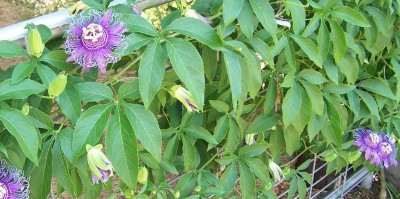
My third least favorite vine is controversial: non-native passionflower (Passiflora incarnata).
Passionflower is a gorgeous exotic-looking white, lavender, red, or purple flower and the vine itself is a larval host plant for various butterflies, including the Gulf fritillary and Zebra longwing.
The problem? Like trumpet vine, it spreads like crazy under the ground and will pop up to smother whatever it can use to climb towards the sun.
It's not quite as invasive as trumpet vine since it's not as tolerant of drought and poor soils, but it can be a real problem to keep contained, especially if you favor a low maintenance garden.
This is one that I always plant in a container to make everyone's life easier. I like to add a cattle panel trellis to a stock tank for freestanding screening (or use two parallel stock tanks and a sheet of cattle panel bent in between to make an arch).
Passionvine brings clouds of butterflies to the yard during the hottest times of year when many of our other flowering ornamentals are heat-dormant. Just don't plant it in the ground! ❦
Lori Daul (aka the Gardener of Good and Evil) is a garden designer, arborist and coach who lives in south Austin. Lori's blog
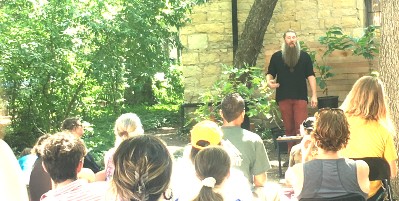 Figbeard addressed a large audience in the back garden of the Herb Bar on a Saturday morning in late June. He spoke extensively (without notes) about the fig tree in myth and mystic traditions, covering the fruit's importance to human evolution, and its role in spiritual tradiitions around the world. ❦
_________________________________________________
NURSERY NOTES: tomorrow (Sat.) at 10 am, Patrick Kirwin shares "lawn for full sun and dry shade" at the Natural Gardener. TNG. 🌿 On Aug. 10, the folks with CharKIDerie present "Japanese Gardens" at Zilker. It is a creativity program where the child + parent/guardian visit the Taniguchi garden, and then make a charcuterie board with veggie sushi, edamame, apple and walnut salad and more. $110 per couple. JG ❦

FATTOUSH RECIPE: this is a tasty bread salad made from toasted or fried pita bread, mixed with a whole mess of mixed greens, radishes, cucumbers, olives, tomatoes and feta.A refreshing summer recipe from an old Edible Austin: Fattoush ❦
________________________________________________
THE AUSTIN GARDEN relies entirely on support from its readers. Please consider making a donation to support this bi-monthly publication. Whether an annual or monthly donation, all are welcomed. (At the moment only 5% of readers support this publication) Many thanks in advance. PayPal link ❦
_________________________________________________
CENTRAL TEXAS GARDENER: hot weather, cool vibes is the theme of this week's episode. A San Antonio couple turn their backyard into a sensory voyage. Liz Pfluger spotlights native plants geared for our weather. PBS❦
|

IT'S ABOUT THYME LEGACY PUBLICATIONS.
CONTACT EDITOR DARREL MAYERS |
|
|